
Matteo Mancuso is one of those rare guitar players who come along maybe once in a generation and stop you dead in your tracks. Tosin Abasi was not wrong when he called Mancuso “the virtuoso of virtuosos”. The unassuming Sicilian is just 26 years old but his debut album, The Journey, is sure to be a reference text for instrumental guitar.
You can pick out the influences but they are all over the map and in different contexts. There is traditional jazz in there. There is fusion. There is rock. Above all there are big moods, and the virtuosity is so casual and matter of fact that it doesn’t call attention to itself until you come to and find that you’ve been unconsciously holding your breath for the past dozen bars.
No one quite plays the guitar like Mancuso. He is 100 per cent fingerstyle, and whether playing a rock lead or jazz guitar lick he alternates between two classical guitar picking techniques; appoggiato, where the picking hand is supported, and tocco libero, where it is not.
Silkroad opens The Journey and is a tasting menu for what’s to come. It has a loose rock groove, Mancuso’s electric guitar of choice – a Yamaha Revstar – all crunch, then a melody snakes its way across the mix, and Mancuso’s classical training comes to the fore in the background. It’s all about counterpoint and contrast, he explains. Hiding the complex behind the simple and vice versa.
The note choices and melodies draw a line between western rock, jazz and North African music. Growing up in Palermo, Sicily, an island between two continents – Europe to the north, Africa to the south – could not help but influence Mancuso’s writing. Mancuso has a sound that’s between worlds.
If you can play, like, 500bpm three-note-per string scales, it doesn’t mean anything if it is not in the right musical context
“In Sicily, and in Italy in general, we have a lot of connections, like Arabic culture, African culture,” he says. “I tried to translate my way of life into the album. There is a lot of Sicilian stuff on there, especially with the mood of the songs. I like to always compose things that are epic and bright. That’s why most of the song are in a major key.”
There has been a lot of people talking about Mancuso and so there has been a lot of expectation of what this album might sound like. Steve Vai said the evolution of the instrument itself was in safe hands with Mancuso. No pressure.
No wonder he took his time with it. The Journey was four years in the making. Working with his father, Vincenzo, a pro guitar player and producer who taught him his first chords, Mancuso put his own studio together. Time was on his side.
“We Sicilians, we like to take it easy, especially in Palermo! And this has always been my way of life,” he says. “I prefer to take it slow, take it easy in every aspect of my life. We tried to experiment a lot with the sounds because we didn’t have to pay someone for the studio.”
I always try to counterpose two things, like a very simple dynamic thing, and then a complex one... If I have a really static chord progression, I try to write a complex melody to it
His father ended up playing on the record, the father-and-son team writing Polifemo and Blues For John together. The latter is almost straight-up traditional jazz. The former? It might shares its title with the Nicola Porpora opera but it’s unquestionably a 21st-century guitar composition, playing fast and loose with genre, stepping in and out of different conventions.
As Mancuso explains, that is always going to be the way of it in the information-rich era of Spotify and YouTube, with influences bombarding us 24/7, and such times call for big personalities. Players with vision. Here he name-checks some of those players, unpacks his fingerstyle approach, and tells us why he is fully onboard with guitar's digital transformation.
You said you always write in a major key. Does that give you more freedom to manoeuvre? Sometimes it can feel a little false going from minor to major.
“Yeah! I think the same thing. I always like to start with a major key. It is sometimes easier to write in a major key. But that’s me. That’s personal preference.”
You play around with moods, where one minute the melody sounds like vintage Peter Green, the next North African. Do you set yourself parameters when you write?
“I don’t follow a specific structure when I compose. Sometimes it is a typical song structure, sometimes it’s not, but I always try to counterpose two things, like a very simple dynamic thing, and then a complex one. I like these two things together in a song.
“If I have a complex chord progression, I play a really simply theme on it, a really simple melody. It’s the same thing the opposite way round. If I have a really static chord progression, I try to write a complex melody to it. I always compose my songs in this way.
“There is a tune called Falcon Flight, and it has this strange kind of chord progression in the background, but the melody is really, really simple. It’s really easy to internalise, but at the same time, there is something interesting for the listener. It is all about balance because if something is too simple you lose the listener’s attention. If it’s too complex, it will be too hard to listen to.”
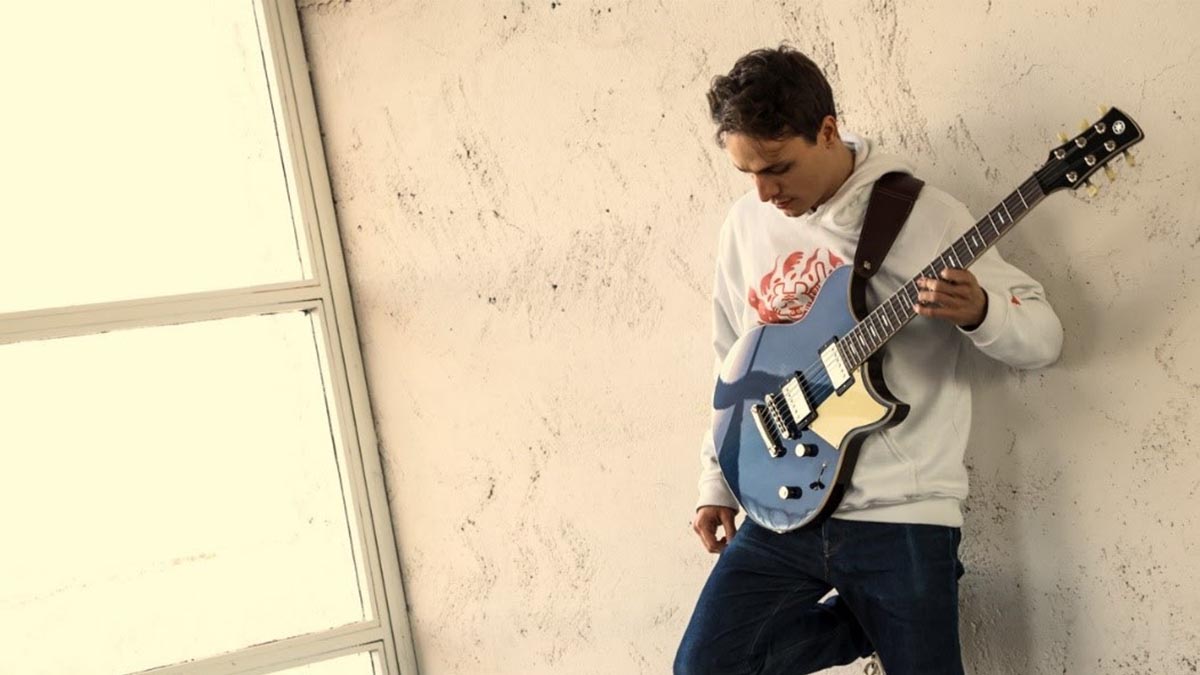
Were you inspired by the play Polifemo for the track? It sounds like the most Sicilian track on the album?
“Actually, with most of the tracks, I first recorded the song and then I thought about the title. The song is first. The title is second. I think the most Sicilian one is Open Fields, because it is dedicated to our Sicilian countryside. I have a lot of olive trees on my countryside home, and actually, the second name for this song was La Campagna Siciliana. That was basically dedicated to the landscape I see every day when waking up. It’s really beautiful here.”
That’s an important point. We need to be looking to the world around us, not getting too focused on the guitar, on just our sound. Guitar culture can drown that out. Life experience can be just as important as developing a technique.
“Sometimes as guitar players we tend to concentrate on our instrument a lot. First of all because it is a really hard instrument to learn. I don’t want to lie, but I spend a lot of time on my instrument. I spend a ridiculous amount of time on my instrument because in order to play like that, and to maintain that level, you have to play every day. You have to concentrate; on technique, on dynamics, the touch, the tone. Everything is hard on guitar.
You have to concentrate – on technique, on dynamics, the touch, the tone. Everything is hard on guitar
“I think it is one of the hardest instruments to learn. And then, when you achieve this kind of freedom on the guitar, when you can visualise things better, when you can improvise a little bit better, then you can think about composing some music. But first you have to achieve that kind of level where you are free on the guitar, where you can really visualise the neck in a really good way.
“And that takes time, of course. It takes a lot of time. We sometimes confuse a thing that is hard on guitar; it is not necessarily good musically speaking. Sometimes it is only hard. That’s why we don’t have to follow really hard things on guitar. If you can play, like, 500bpm three-note-per string scales, it doesn’t mean anything if it is not in the right musical context.”
Guitar is difficult to learn and it can be a little painful. Maybe there is something about that pain that makes the bond between guitarists and their instruments stronger. It's as though the guitar fights back.
I don’t like to work only on my technique, or only on my legato, or on my timing. I like to work on these together
“Yeah, sometimes, especially on classical guitars. I started classical guitar when I was around 14 years old. The thing with classical guitar is that you need to have a really strong left hand because you do a lot of barre chords, you do a lot of polyphonic stuff rather than the electric guitar that is more focused on the solo.
“That’s when the pain is really strong! Because first of all you have to build these muscles, both on the left and the right hands, but when you build your muscles, and when the muscle memory kicks in, you become really good.
Sometimes we guitar players search for this pain, because when there is this pain it means that we are improving. It is a really masochistic thing sometimes.”
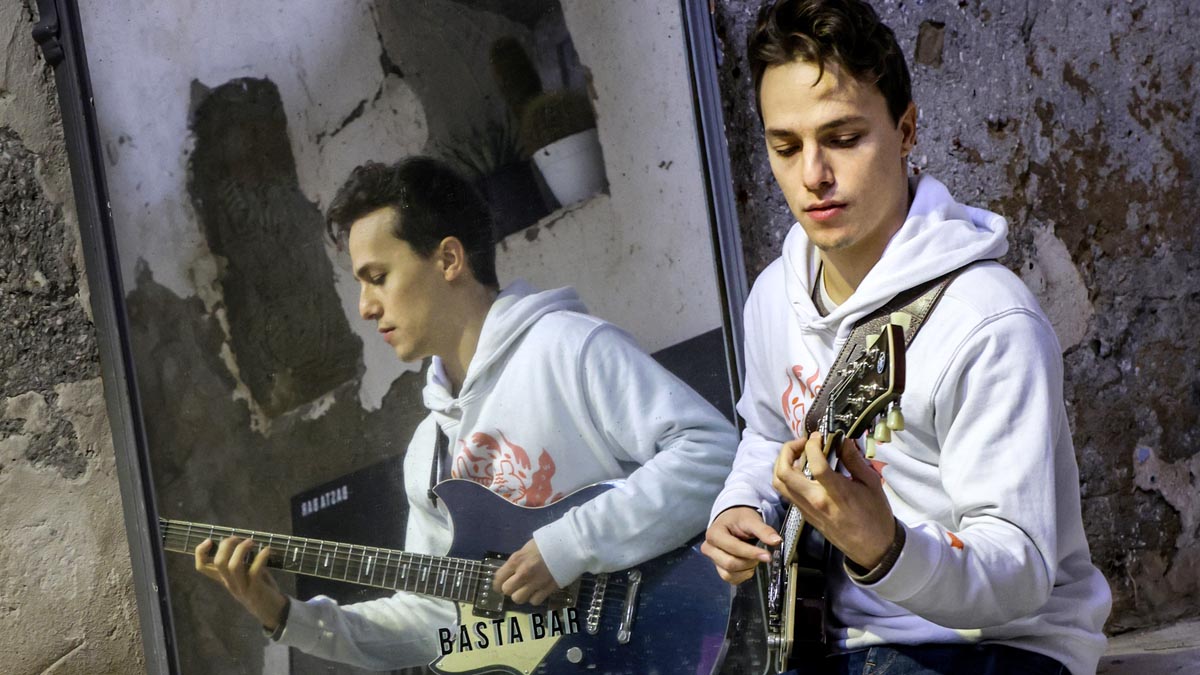
What is your practice routine like?
“I spend a lot of time playing guitar. I try to play everyday. I don’t have a really rigid practice routine, like arpeggios for 30 minutes then scales for one hour! I don’t have that type of practice routine. I just grab the guitar and play what excites me most in that moment. I always try to learn songs, because for me repertoire is a very important thing, and when you learn songs you learn a lot.
“Musically speaking, the three most important things are rhythm, melody and harmony. You can learn these three things when you are learning a song. That’s what I try to do everyday. I try to learn repertoire. I try to work on my solos, of course. I try to work on my technique.
“But I like to work on these together. I don’t like to work only on my technique, or only on my legato, or on my timing. I like to work on these together, and that’s how my practice works. I try to play at least two, three hours. Sometimes I play more. Sometimes I play less. But I try to play everyday because consistency is the key.”
You play fingerstyle electric guitar. How did you develop that technique and do you think this gives you a certain advantage with muting?
“I think there are advantages and disadvantages with fingerstyle technique, especially if you apply it to the electric guitar. First of all, I actually started with the electric guitar when I was 10 years old because my very first influences were all electric guitar players like Jimi Hendrix, Angus Young from AC/DC, Led Zeppelin, Deep Purple… Those were my very first musical influences.
“Then I started to study a little bit of classical guitar because my father is a guitar player. I always saw him playing classical guitar with fingers, and I just thought that every guitar was meant to be played like that – only with fingers. That’s why I started electric guitar like that. I have two main techniques for my right hand.
I always saw my dad playing classical guitar with fingers, and I just thought that every guitar was meant to be played like that
“In Italian it is called [tocco] appoggiato technique and this is called tocco libero [free touch], and what I do is I mix these two different techniques, and of course it depends on what I have to do. For example, if I have a three-note-per-string scale, I tend to use this [tocco libero] technique because it is more useful for scalar things.
“With this [appoggiato] technique, I mainly use it for big arpeggios, or skipping stuff because it is more useful if you want to skip the strings. You basically have four picks available. So it is a mix of these two techniques.
“The advantage is you can build more unusual patterns for electric guitar because you can skip whatever string you want. You can start a pattern from whichever string. Only with the pick, it’s not that easy sometimes. With a pick, it’s easier if you are playing on the same string.
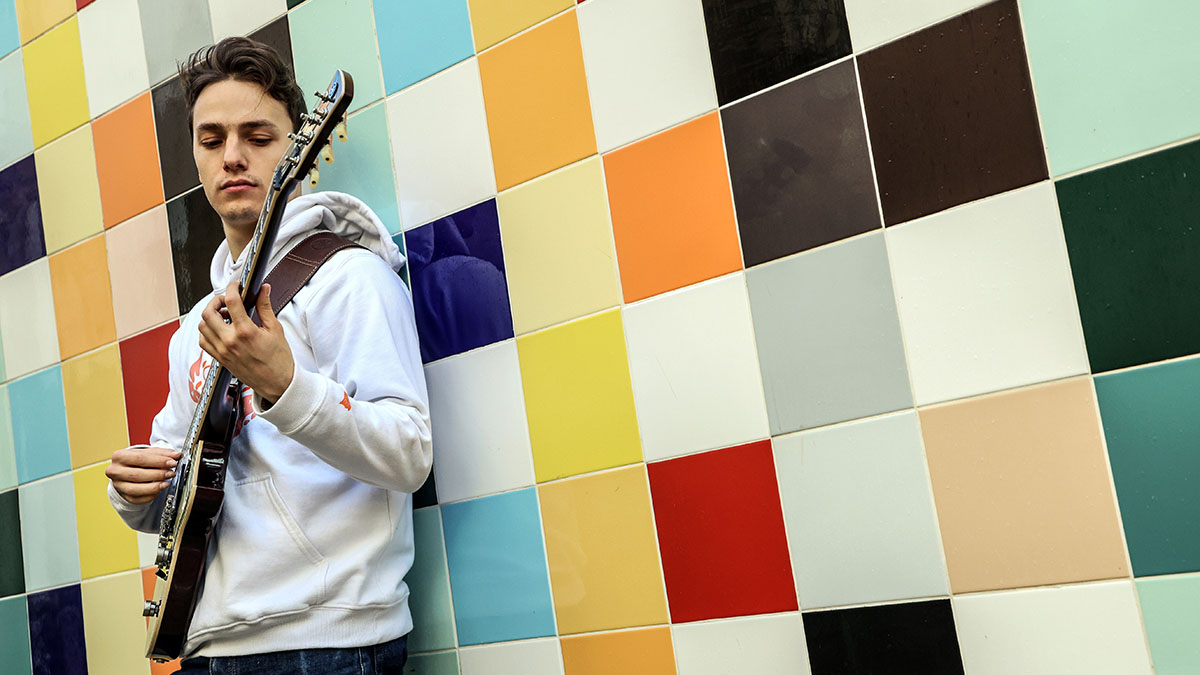
“Alternate picking is easier to learn rather than fingerpicking on the same string, but actually fingerstyle, or fingerpicking in general, is more useful if you want to concentrate on arpeggios or string-skipping. It lets you have more freedom on this area of the guitar. I mix those two techniques.
“I play very light with my right hand. I don’t play very hard because I am more relaxed when I play soft, but of course you can only do that on the electric guitar because on the classical you need to have volume – especially on the right hand, so with the classical guitar, I play a lot harder than with the electric.”
Is your guitar amp up loud when you are playing electric?
“Not that much. I prefer to hear a lot of the guitar but I don’t want to have too much volume on the stage. I mostly play in a trio setting, and I want to really hear the drums, so, in a trio, from a volume perspective it is drums first, guitar, then bass.”
One last thing about fingerstyle, it does give you more possibilities to be more individualistic. Every guitar player has their own touch and feel on the guitar, and with fingerstyle, there is even more contact.
“Yeah, in a way this technique forced me to find a new voice, because back when I was listening to Eric Johnson or Allan Holdsworth – or Eddie Van Halen, who is a really big influence for me – I can’t really play their licks in the exact way they played it, because, of course, they played it with a pick.
I never learned an Allan Holdsworth solo. I learned the spirit of it, the sound and the way he approached the notes, and that is the important thing to me
“So I always try to find a way to translate their licks to my technique. I change maybe the direction of the line. I change the fingering. All of these differences mixed together formed my way of playing guitar. This technique forced me to find new approaches.”
There is always this focus on being able to play someone else’s licks, rather than taking the spirit of it and using that to make ourselves more interesting guitar players.
“It is more important to copy the spirit of the solo rather than the notes of the solo. For example, I am a big fan of Allan Holdsworth, and Allan, most of the solos are impossible for me. They are in a completely different league, so I never learned an Allan Holdsworth solo. I learned the spirit of it, the sound and the way he approached the notes, and that is the important thing to me. You have to copy that spirit, not only the notes.”

What is exciting about guitar right now is how quickly the culture has evolved, how quickly the talent is developing. In six months time, we could be talking about this new guitar player who was influenced by you.
“Yeah, I sometimes go on YouTube and find covers of my songs with the fingerstyle technique and I am really happy because what I am trying to do is inspire people to pick up the guitar. So I am really happy if someone is doing what I do.”
You are playing a Yamaha Revstar at the moment, a really underrated guitar, from the most underrated guitar company ever. What do you like about the model?
“I am a really big fan of the Gibson SG. That was my very first professional electric guitar – because I was a very big fan of Angus Young, so I needed an SG! And, actually, the Revstar is really close, sonically speaking, to an SG. I really like the sound of a humbucker in general because it is close to what I have in my head for my lead sound.

“The Revstar was really similar to that sound, and I started playing an 820. That was my very first Revstar. And then in 2019, they built a custom Revstar for me, and it is really similar to the Yamaha Revstar Professional – really similar – but it has some little differences.
“I have the Lollar Imperial pickups. The body is chambered; that is for weight-relief but it also has this kind of jazzy tone when you use it clean. I really find myself thinking about professional guitars in general, and what separates them from the budget category.
“Right now, Yamaha is really good at making cheap guitars sound professional. Also, my Pacifica, I really don’t think you can find a really good Strat[-style] at that price. It is a really good instrument. Of course, there are better Strats out there but you really have to go up in price.”
Yamaha also have the SG2000. Were you ever tempted by that?
“No, I never tried the SG2000 but I know it is a really heavy instrument and it’s not for me. I prefer light guitars. That’s why I never tried one, why I have never played a Les Paul live. Because it’s too heavy for me! I always preferred the SG. You don’t have to fight with the instrument. The instrument allows you to play in the best way. I like ergonomic designs. They let you be more relaxed when you’re playing.”
Ninety per cent of the sounds you hear on the album are the Line 6 Helix.... The rule I follow is always to use digital
The tones are really great on this record. Did you use your Line 6 throughout?
“Thank you! I mainly used the Line 6 Helix for… Basically 90 per cent of the sounds you hear on the album are the Line 6 Helix. I sometimes use plugins from Universal Audio. On Drop D, which is kind of the rock song on the album, I used a simulation of a Marshall JCM800.
“Sometimes I use different pedalboards but the rule I follow is always to use digital. First of all, because I am a lazy guy! [Laughs] I don’t like to mic an amp and adjust all the volume and stuff. I prefer to use digital both for recording and live. It feels way more reliable than analogue.
“I don’t know why but every time I try to record an analogue amp it feels fuzzy and noisy, and the sound you have today is not the sound you get tomorrow with an analogue amp because it changes a lot. It changes with mic position. Maybe the tubes are not warm enough. All of that. With digital, you always have the same sound every day. It is more reliable from that perspective.”
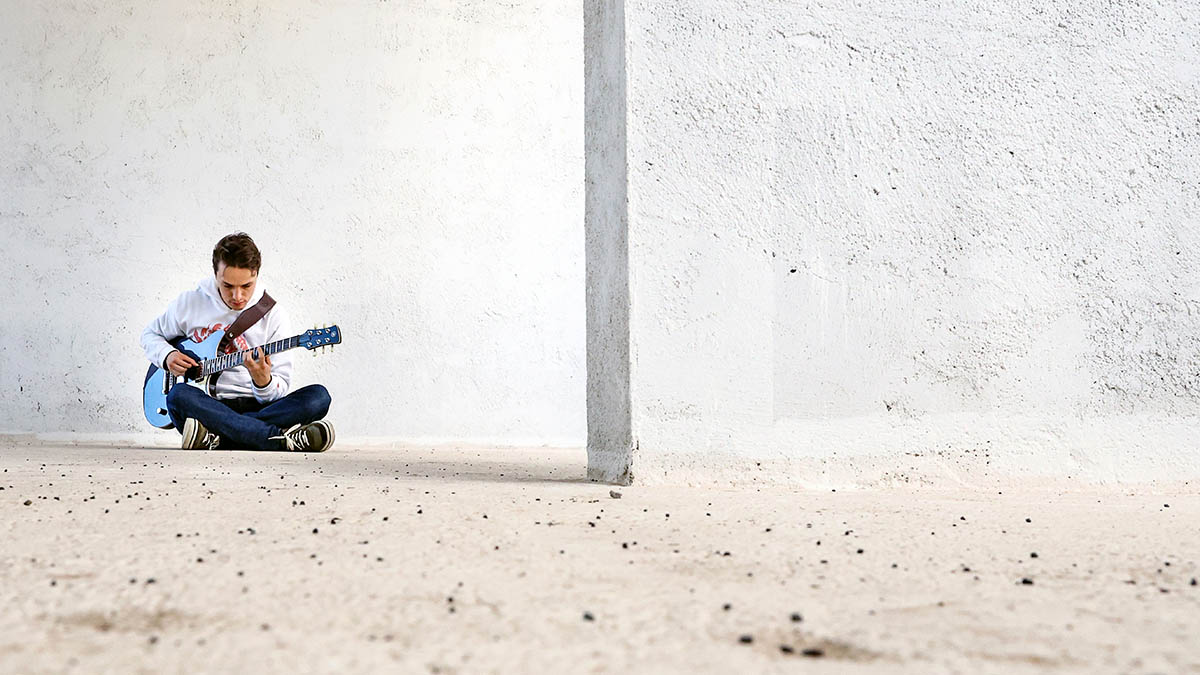
You have had some incredible experiences jamming with Al Di Meola and more recently with Tommy Emmanuel. What was that like?
“It was incredible. First of all because it was in my town. It was in Palermo. His manager called me a few days before the concert and asked me, ‘Do you want to come to the concert?’ ‘Yeah!’ And the next day, Tommy himself called me and he said, ‘Hey, Matteo, do you want to play with me?’ I say, ‘Of course! Why not?’
“It was a Friday night. We played three songs, and it was incredible because it felt like we were rehearsing for two, three weeks, because everything was so smooth and he is such a good rhythmic player. His comping was top-notch, y’know! Yeah, it felt really good because Tommy is a really good person, and I always felt, from the start, that he was like a close friend. Tommy is such a nice person.”
The great musicians have this ability to sit in with people and make it feel so natural.
“It was so natural. He has such a wide repertoire of songs, from the ‘70s songs, hit songs, the Beatles stuff, he has such a wide repertoire. You can play everything with Tommy.”
Do you still play with your dad?
“Yeah, sometimes. We mostly play at home. We don’t play gigs anymore. He is mainly a jazz player, so he knows a lot of jazz standards, but he also worked as a popular guitarist, as a touring musician, especially in the ‘90s. Now, not so much. He considers himself more of a producer than a guitar player, because he produced a lot of Italian CDs from the ‘90s.
“He is a really incredible player. My father is one of my first influences for sure. He taught me a lot. I basically learned the first chords on the guitar through him. He was more than a teacher. He was like a listening guide for me because I came to know all of the traditional jazz players thanks to him, like Wes Montgomery, Barney Kessel, Django Reinhardt.
“He always was a really good listener. He didn’t impose any stuff on me. I was really free to listen to anything I wanted, to play anything I wanted. So I have to thank him a lot for that.”
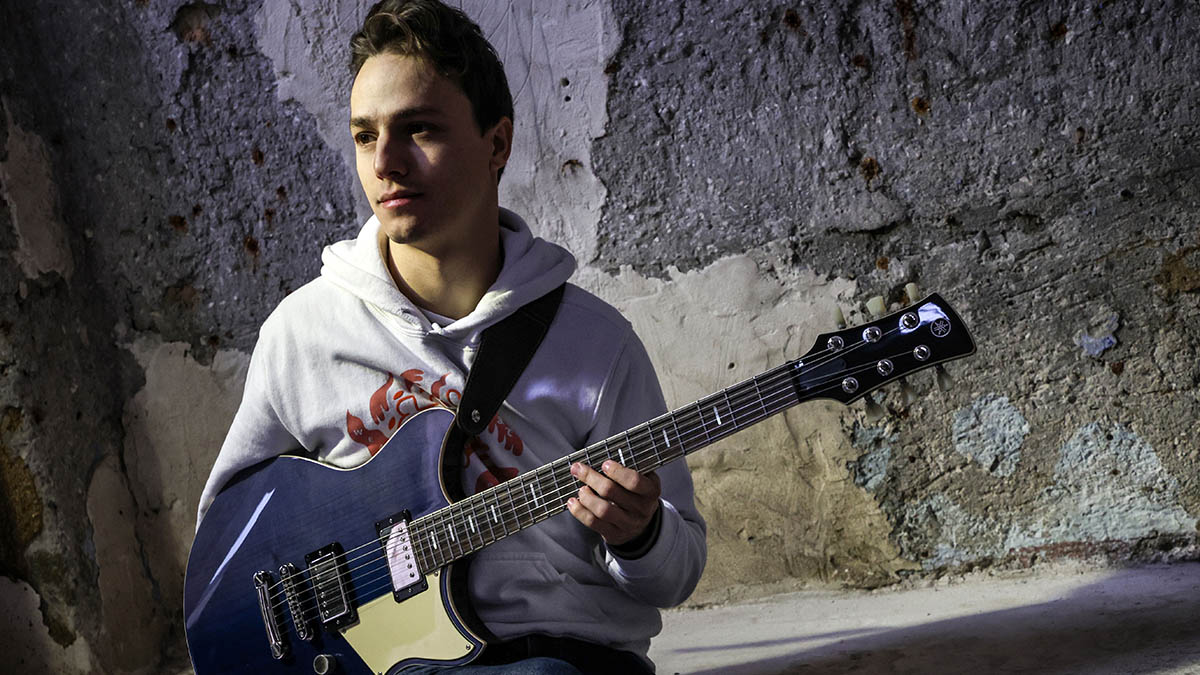
You’re right. We are all heading in that direction. We are all turning fusion. The barriers between different cultures, different styles of music, all of this, they have all come down.
“Our generation is like that because we have had so much information since we were kids and from the ‘90s, as well. I am 26 years old. My generation was born right before the internet boom. That’s why we had so much music to listen to as kids. We can’t just play traditional jazz.
“For example, Wes Montgomery. Wes Montgomery is Wes Montgomery because he only listened to that kind of jazz. In a way, it was easier for him to sound like Wes Montgomery because at the time you could only listen to that kind of music. Now it is harder for us to find our kind of music because sometimes we have too many influences. It is a good thing, of course, but it can be confusing for our generation.”
It means young artists really need to know who they are, to understand what they want to say. That almost requires a bigger force of personality.
“Personality is now more important than ever because right now the technical level is so high it is not new to be incredibly good at guitar. On a technical level, it is expected to play guitar really well, but right now the level is so high that people want to hear something original other than being good at your instrument.”
They need something that speaks to their imagination. It’s about giving people an experience.
“Yeah, it is all about giving people an experience, giving people emotion through your sounds.”
Which current players excite you?
“I know a lot of people who are really good – even from Italy. One of the first that comes to mind is a guitar player called Christian Mascetta. He is from Abruzzo. He is a really incredible guitar player. He is really influenced by people like Wayne Krantz or Scott Henderson – those blues players with a lot of jazz background. I think of him like that. He is a really incredible player, really solid. His timing his incredible.
“Andre Nieri is a guitar player from Brazil, and he has this kind of hybrid right-hand technique. He plays with a pick but also with all four fingers sometimes, so he holds his pick on the ring finger. I do not know how it works but he is incredible.
“Then there is this kid from Russia. He’s called Max Ostro. He is technically speaking one of the best players I know, for sure. He is like a fusion of Bumblefoot and Guthrie Govan. And he has a lot of legato elements in his playing. Technically speaking, for sure, he is one of the best I’ve seen on the internet.”
- The Journey is out now in Italy, is released everywhere else on 21 July, and is available to preorder via Mascot Label Group/The Players Club.







